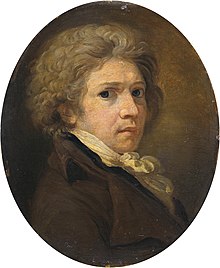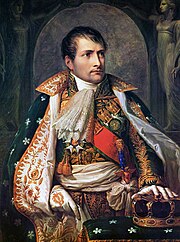art.wikisort.org - Artist
Andrea Appiani (31 May 1754 – 8 November 1817) was an Italian neoclassical painter.
Andrea Appiani | |
|---|---|
 Self-portrait, 1790s | |
| Born | 31 May 1754 Milan |
| Died | 8 November 1817 (aged 63) Milan |
| Nationality | Italian |
| Known for | Painting |
| Movement | Neoclassicism |


Life
Born in Milan, it had been intended that he follow his father's career in medicine but instead entered the private academy of the painter Carlo Maria Giudici (1723–1804) where he received instruction in drawing, copying mainly from sculpture and prints. From there, he then joined the class of the fresco painter Antonio de' Giorgi, which was held at the Ambrosiana picture gallery in Milan. At the same time, he also frequented the studio of Martin Knoller, where his knowledge of painting in oils was deepened. Also, he studied anatomy at the Ospedale Maggiore in Milan with the sculptor Gaetano Monti.
Appiani's interest in aesthetic issues was stimulated by the classical poet Giuseppe Parini, whom he drew in two fine pencil portraits. In 1776 he entered the Brera Academy of Fine Arts to follow the painting courses of Giulio Traballesi, receiving a mastery of the fresco technique. Among his masterpieces are the frescoes depicting the four evangelists and doctors of the church that he painted for the cupola and pendentives for the church of Santa Maria presso San Celso in 1795[1] and the fresco with The Parnassus, representing Apollo and the Muses, on the ceiling of the dining room of Royal Villa of Milan. Another masterpiece are the frescoes depicting Allegories of Virtues and others honoring Napoleon in the rooms of the Royal Palace of Milan.[2]
Although created a pensioned artist to the Kingdom of Italy by Napoleon, Appiani lost his allowance after the fall of the Kingdom in 1814 and fell into poverty. During his period as court painter he rendered portraits of Napoleon and the chief personages of his regime, among the most graceful of which are his oil paintings Venus and Love, and Rinaldo in the garden of Armida. He is known as "the elder", to distinguish him from his great-nephew Andrea Appiani, an historical painter in Rome.[3]
Appiani painted a large canvas of the Encounter of Rachel and Jacob for a church in Alzano. The Brera has a fresco by Appiani representing Olympus.
He died at Milan in 1817. Among his pupils are Antonio De Antoni, Carlo Prajer, Angelo Monticelli, and Giuseppe Bossi.[4]
Gallery
- Nicolas Frochot
- General Desaix
- Ugo Foscolo
 Josephine
Josephine Josephine, Queen of Italy
Josephine, Queen of Italy- The Olympus
- Hercules at Crossroads
- Jupiter, Mercury, Philemon, and Baucis
- Head of Laocoön, about 1790
- Eugène Beauharnais, portrait by Appiani, 1800.
- The Evangelists, detail
- The Parnassus, detail
References
Notes:
- Andrea Appiani (1803), Descrizione dell' opera a fresco eseguita nel 1795 nel tempio di S. Maria presso S. Celso in Milano dal pittore Andrea Appiani, Milano: Presso Pirotta e Maspero, OCLC 145947448, OL 24970360M
- Luigi Lamberti (1809), Descrizione dei dipinti a buon fresco eseguiti dal signor cavaliere Andrea Appiani nella sala del trono del Real Palazzo di Milano, Milan: Dalla Stamperia reale, OCLC 644307069, OL 25091179M
- Chisholm 1911.
-
- Caimi, Antonio (1862). Delle arti del disegno e degli artisti nelle provincie di Lombardia dal 1777-1862. Milan, Italy: Presso Luigi di Giacomo Pirola. pp. 48–49.
Sources:
- This article incorporates text from a publication now in the public domain: Chisholm, Hugh, ed. (1911). "Appiani, Andrea". Encyclopædia Britannica. Vol. 2 (11th ed.). Cambridge University Press. p. 222.
- Domenico Sedini, Andrea Appiani, online catalogue Artgate by Fondazione Cariplo, 2010, CC BY-SA.
External links
На других языках
[de] Andrea Appiani
Andrea Appiani (* 23. Mai 1754 in Mailand; † 8. November 1817 ebenda[1]) war ein italienischer Maler des Klassizismus, der von seinen Zeitgenossen der „Maler der Anmut“ (Pittore delle Grazie) genannt wurde, weil er „[…] dem heroischen Stil Jacques-Louis Davids eine liebliche Eleganz hinzufügte.“[2]- [en] Andrea Appiani
[es] Andrea Appiani
Andrea Appiani (Milán, 31 de mayo de 1754 - Milán, 8 de noviembre de 1817) fue un pintor neoclásico italiano.[fr] Andrea Appiani
Andrea Appiani, né le 31 mai 1754 à Milan et mort le 8 novembre 1817 dans la même ville, est un peintre italien néoclassique.[it] Andrea Appiani
Giovanni Andrea Melchiorre Appiani (Milano, 31 maggio 1754 – Milano, 8 novembre 1817) è stato un pittore italiano.[ru] Аппиани, Андреа
Джованни Андреа Мельхиорре Аппиани (итал. Giovanni Andrea Melchiorre Appiani; 23 мая 1754, Милан, Ломбардия — 8 ноября 1817, Милан) — итальянский живописец неоклассического направления. Известен как «Аппиани Старший», в отличие от своего внучатого племянника Андреа Аппиани Младшего (1817—1865), художника исторической живописи из Рима. По фамилии Аппиани известен ещё один итальянский художник, родившийся в Мюнхене и работавший в Германии: Джузеппе (Йозеф Игнац) Аппиани (1706—1787), последователь Якопо Амигони[6].Другой контент может иметь иную лицензию. Перед использованием материалов сайта WikiSort.org внимательно изучите правила лицензирования конкретных элементов наполнения сайта.
WikiSort.org - проект по пересортировке и дополнению контента Википедии











